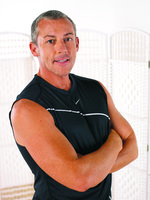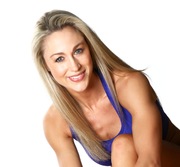|
Press
|
|
By Dean Hodgkin and Caroline Pearce
ISBN: 978-1-4504-3276-4
Binding: Paperback
Pages: Approx. 264
Price: $19.95
Available: October 2013
Champaign, IL—Genetics play a huge factor in how the body responds to exercise. The average gym contains people of all shapes and sizes, and even those deemed “very fit” will have varying body shapes and response patterns to exercise in the way they develop muscle, burn fat, and improve their cardiorespiratory fitness. “Simply doing the same training as somebody whose body you admire and want for yourself may not work for you,” says fitness expert Dean Hodgkin. “Attaining your goal may require you to train specifically for your body type.”
In the forthcoming book Better Body Workouts for Women (Human Kinetics, October 2013), Hodgkin and former international athlete and fitness presenter Caroline Pearce explain the three body types and the training recommendations associated with each one to create an effective exercise program. “Body shapes have typically fallen into one of three categories: mesomorph, ectomorph, or endomorph,” Pearce explains. “In reality, most people will share characteristics from all three categories, but it is likely that you will identify with one category more than another. Each category has its own advantages and disadvantages in terms of health and fitness, but your understanding of these is the key to your success.”
Mesomorph
The athletic physique for a mesomorph includes broad shoulders, narrow waist and hips, good muscular definition, low body fat, and a reasonably fast metabolism. Mesomorph body types respond well to most types of training—especially resistance and body shaping exercises—and sustain low levels of body fat. “The disadvantages for mesomorphs are they can often become overtrained, so they should be mindful of incorporating rest days and lighter training sessions into a training program,” Hodgkin says. “Also, stagnation can easily occur if they are not challenged with varying exercise routines, and they can put on weight quickly when training stops.”
Here are recommendations for mesomorphs:
- Combine both major and minor muscle group exercises into an exercise routine.
- Use superset training to maximize effort during workout time.
- Progress training regularly and keep it varied with regard to exercise modality, type, and intensity.
- If trying to minimize muscle mass, favor steady-state and interval training over maximal sprints and lifts. Also practice yoga, Pilates, and light-weight, high-repetition circuit training to develop longer, leaner muscles.
- If trying to maximize muscle, allow adequate recovery between exercises and sets and between weight training sessions. This allows regeneration of energy systems in the first instance and muscle adaptation in the latter.
Ectomorph
The athletic physique for an ectomorph includes narrow shoulders and hips, long and lean legs and arms, small bone structure, and very little body fat. “Ectomorph body types find it easy to lose weight and keep it off,” Pearce says. “They respond well to cardiorespiratory training and are ideally suited to this type of training because of their light frames and low body weight.” But ectomorphs find it difficult to put on muscle and create shapely physiques, are prone to injury because of fragile frames, and risk unhealthily low body fat levels.
Here are recommendations for ectomorphs:
- Use split training, which involves only one or two body parts with resistance exercises per session, and aim to work each body part once per week.
- Take adequate rest between strength workouts to allow for muscle recovery and for optimal repair and adaptation (48 to 72 hours).
- Use heavy, basic power movements that target the deep muscle tissues.
- Use repetitions of 5 to 10 and perform 3 or 4 sets of each exercise.
- Keep cardiorespiratory activity to a minimum (max three times per week) if the goal is to shape up and develop more muscle.
- Ensure good intake of protein and carbohydrate; greater caloric intake than usual will be essential in maintaining body weight and developing lean muscle.
Endomorph
The athletic physique for an endomorph includes wide hips and narrow shoulders that create a pear shape. They have less muscle definition, uneven fat distribution (mostly accumulating in upper arms, buttocks, and thighs), wide bone structure, and a slower metabolism than the other body types. “Weight gain is easy and fat loss difficult if you are in this category, and muscle definition tends to be hidden by fat,” Pearce explains. “Endomorph body types respond well to power and strength training due to natural strength. If muscle is trained and developed, then metabolic rate and fat burning can increase effectively.” The disadvantages for endomorphs are that they can look bulky with too much weight training in relation to aerobic activity and can suffer joint problems if carrying too much body weight. They also can find it more difficult to burn fat.
Here are recommendations for endomorphs:
- Include moderate-intensity, nonimpact cardiorespiratory exercise such as cycling and power walking on most, if not all, days of the week to achieve a leaner, lighter body shape.
- Cross training should be the basis for a training plan.
- Keep weights light, rep range 10 to 25, and recovery time short.
- Eat regularly and reduce starchy and sugar-based carbohydrate.
“Of course, genetics determine that some people are naturally leaner and more responsive to exercise than others,” Pearce says. “With this in mind, you need to be realistic with your goal of ideal body and training targets. But the good news is that with the correct training for your body type, you can really push the boundaries of your genetic predisposition and be the best you can be.”
Better Body Workouts for Women provides the best methods for assessing current fitness levels, identifying physical strengths and deficiencies, setting and refining training goals, and selecting and customizing programs to make an immediate and lasting impact. For more information on Better Body Workouts for Women or other fitness resources, visit www.HumanKinetics.com.

|

|
|
Dean Hodgkin was the resident fitness writer for Bodyfit magazine, contributing editor at Zest and a regular contributor to various other publications, including Health & Fitness, Women’s Fitness, Cosmopolitan, Weight Watchers, and She. His writing can also be seen in the Times, Daily Express, News of the World, FHM, Men’s Health, and GQ.
Hodgkin is an experienced presenter, having appeared on various television and radio shows internationally and in more than 20 fitness videos and DVDs. In addition, Hodgkin regularly presents master classes and seminars at trade and consumer events in 36 countries, including the United Kingdom and United States. The recipient of the International Fitness Showcase 2012 Lifetime Achievement Award for services to the fitness industry, he was also voted Best International Fitness Presenter at the One Body One World awards in New York. He is a three-time world champion and two-time European champion in karate. Hodgkin lives in the United Kingdom.
Caroline Pearce is a former international athlete and a current nutritionist, fitness consultant, model, and TV presenter. She holds a first class honors degree in sports science and master’s degree in nutrition and exercise physiology from Loughborough University. She has contributed to and has been featured in and on the cover of numerous fitness and health magazines, including Bodyfit, Women’s Health & Fitness, Women’s Fitness, Zest, Ultra Fit, WorkOut Magazine and Muscle & Fitness.
Pearce’s athletic career started when she represented Great Britain at the age of 15 in the pentathlon and progressed to senior honors and a place in the European Cup heptathlon team at the age of 24, where she helped the team secure their place in the Super League. She is a two-time national AAA heptathlon champion and a silver medalist in the long jump. She transferred her speed and power to ice and made her debut on the Great Britain bobsleigh team at the World Bobsleigh Championships in Calgary, where the Team GB won the silver medal. Her athletic success led her to become the face of the Adidas/Polar clothing line and model for sporting brands Nike, Reebok and Speedo. She is also the official spokesperson for Power Plate delivering accredited courses to trainers, professional sports teams and healthcare officials around the world. In 2008 Pearce took a role as Ice on the television show Gladiators, the UK franchise of the popular American Gladiators television program and she is now a regular TV sport and fitness presenter. Pearce lives in the United Kingdom.
Contents
Chapter 1 Training Essentials
Chapter 2 Assessment
Chapter 3 Fueling for Recovery and Performance
Chapter 4 Warm-Up and Cool-Down
Chapter 5 Building Strength
Chapter 6 Aerobic Training
Chapter 7 Anaerobic Training
Chapter 8 Agility Training
Chapter 9 Increasing Power
Chapter 10 Personalizing Your Program
Chapter 11 Sample Workouts and Programs
Chapter 12 Training Diary

|
 Dean Hodgkin |

 Caroline Pearce |

|
- Resistance training actually breaks down the muscle at a cellular level, and the body absorbs protein into the muscles to help them repair. The phenomenon at work, known as super-compensation, allows the muscles to absorb more than is required to repair themselves and so the muscle fibers become thicker and therefore stronger. Over time people will become stronger and if they are working out regularly, the loads they lift will need to be incrementally increased for each exercise, which is referred to physiologically as the principle of progressive overload.
- If the workout goal is weight loss, then avoid a last-minute preworkout snack, because the carbohydrate boost it provides will delay fat burning while your body works to metabolize the carbohydrate as the primary fuel.
- Hydration levels before a workout can directly influence performance. Even mild dehydration can reduce exercise intensity and duration. You can prevent the onset of dehydration during exercise by drinking water before starting a workout. This does not mean glugging copious amounts of water immediately before a workout, because that will simply dilute essential electrolytes, mainly sodium, which is important for muscle contractions.
- Circuit training and other sessions involving high-volume workloads and short recoveries have been shown to increase VO2max. Additionally, heavy resistance training can improve aerobic capacity in deconditioned individuals.
- Anaerobic exercise, especially resistance exercise, has been found to elevate testosterone, growth hormone, and cortisol for up to 30 minutes after exercise. This effect is more pronounced in men but can be found in women as well. Increases in testosterone can produce greater strength development. Consistent resistance training will lead to chronic changes and the ability to exert more effort in successive training sessions.
- Plyometrics are exercises used to produce power. Women often use plyometrics to improve sport performance. These exercises involve a series of explosive movements that stretch the muscles like a rubber band and then contract them again quickly, enabling fast, powerful movements in sports. Plyometrics actually reduce the time it takes for a muscle in the body to contract, which allows the muscle to exert a greater amount of power and force.
Source: Better Body Workouts for Women (Human Kinetics, 2013)
Interview Questions
- How can hula hooping help develop agility?
- What is Fartlek training and how can it be incorporated into a workout?
- To maximize fat loss, why should training focus on total calorie burn rather than percentages from fat as a fuel source?
- Explain the 30-minute window after a workout and what people should eat during this time.
- If your goal is to lose body fat and become leaner, why is anaerobic training more effective than aerobic training?
- What are the benefits of interval training?
- What is the difference between slow-twitch and fast-twitch muscle fibers?
- How do vibration plate exercises help to improve power?
- How often should an average fitness enthusiast include a power endurance workout into their weekly fitness routine to see results?
- What are the benefits of using a training diary?

|
|
|
|
|

|
 
|